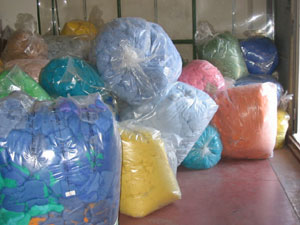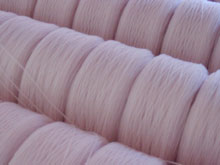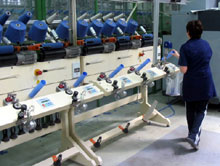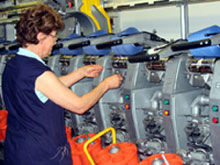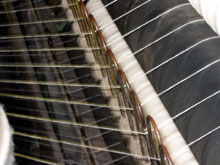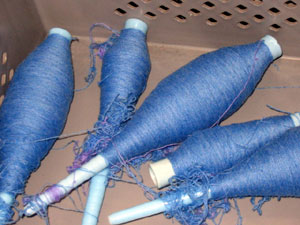|
|
From the long-haired sheep of Inner Mongolia to the fashion runways
of Milan via Cagli, cashmere makes its way to the world’s
designer clothing market.
The Cariaggi fine yarns factory, which opened in 1960, represents
a family business’s dedication to quality and competition
in the global market.
The Cariaggi family and its cashmere thread factory link diverse
cultures through a world of looms, spinning machines and high production
standards. Situated on the side of the ancient Via Flaminia on the
outskirts of Cagli, Italy, the factory is broken down into eight
modules whose noisy interiors are dispersed amongst the tranquil
backdrop of central Italy’s mountains.
|
| Cristiana Cariaggi, the factory’s communications
manager, said when her father and grandfather opened the factory
it produced general textiles. In the past decade, it switched to
cashmere thread production to compete globally. The factory’s
threads end up in cutting-edge fashionable clothes on the runways
of Milan.
The factory faces a handful of logistical complications because
of its distance from major metropolitan cities, but there are benefits
to this location. “We set our own goals because we are not
surrounded by competitors. No one influences the way that we do
our work, and this keeps us motivated to keep our high standards,”
she said.
Cariaggi said that Cagli is a strange area for textile production
because the area mostly produces furniture, shoes and leather goods.
The factory trains its 135 workers because the product is highly
specialized, she said. The exported threads all bear the Cariaggi
fine wool trademark to preserve family values and tradition.
|
|
|
The factory purchases its raw materials through a society that
deals with the sheepherders of Inner Mongolia in Communist China.
This alleviates import problems, said Cariaggi.
The factory purchases the materials approximately one year before
manufacturing. Raw materials usually arrive in Italy by boat, through
sometimes by air.
After the materials arrive, factory workers test the durability,
quality and usability of the materials in order to preserve high
standards, Cariaggi said. Some of the raw material is dyed and combined
with several different types of threads such as cotton, silk and
wool before production begins.
The Cariaggi Factory belongs to another society, CCMI, the Cashmere
and Camel Hair Manufacturers Institute, which is an international
association that deals with high value cashmere and camel hair products.
They are members in order to assure the quality of their products
and remain competitive. This is necessary because the cashmere industry
has recently experienced an influx of synthetic and cheaper materials
and imitation products, said Cariaggi.
|
|
The CCMI sends all materials through a series of microscopic analyses
that guarantee quality to high-end clients. “Because our products
are very high in value, many competitors attempt to outsell us with
cheaper, imitation products. The CCMI assures the customer market
of the quality of the goods they are paying for so they do not settle
for cheaper imitations and we do not lose business,” said
Cariaggi.
Membership in the CCMI is particularly important at the moment because
the factory is doing very well financially, said Cariaggi. The factory
is taking advantage of the recent changes in worldwide economics,
especially in the United States and among members of the European
Union. The devaluation of the U.S. dollar and the strength of the
euro play key roles.
Cariaggi said that the factory purchases some 300,000 kilograms
of raw materials per season for between $80 and $83 U.S. per kilogram.
Once this raw material is transformed into pure cashmere or cashmere-blend
threads, the factory sells some 400,000 kilograms to various customers
for 100 euro per kilogram.
|
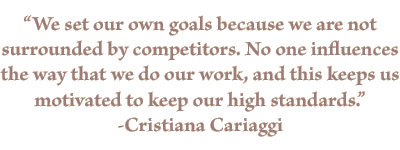
|
|
Approximately 80 percent of the factory’s output is sold
within Italy to high-prestige clothing manufacturers, and 20 percent
is exported to the United States, Hong Kong, Shanghai, South Korea,
Japan, Great Britain, France and Germany.
The factory continues to produce only threads because of the unique
importation of raw material from Mongolia and because of the high
quality of the specialized product that they produce. The threads
are displayed at the annual Pitti fashion convention in Florence,
but some customers come to Cagli. Either way, Cagli’s cashmere
ends up in lavish fashion shows all over the world.
|
|





